Introduction
When it comes to the nuclear weapons issue, America could do no wrong. Literally all the media’s coverage of any public opposition was framed in the worst possible light, at best as “commie dupes”. For decades, there was no crack between the government’s Public Relations campaign and how the media covered the issue.
The same could be said for nuclear energy and how it was promoted, with claims that the “Atoms for Peace” campaign would make electricity “Too Cheap to Meter!” Yet, opposition sprung up almost from the start, especially in California where the country’s largest electric company at that time, Pacific Gas & Electric Co. (PG&E) announced plans to build a large complex right on top of the San Andreas fault line that destroyed San Francisco in 1906. Bob Hope and other Hollywood movie stars would turn anti-nuclear as well in the early 1960’s when plans to build a large nuclear complex outside of Malibu surfaced.
But again, never would America’s mainstream media ever, but ever dare to cover any opposition fairly, or more to the point with honesty. Always attacking the opposition with the broadly framed position that nuclear was in America’s best interest.
This would change somewhat following the nuclear meltdown at Three Mile Island. Frightened national coverage of the disaster was soon followed by a growing number of investigative reports done by a number of major media outlets. Reports that detailed the growing concerns about both this country’s nuclear weapons and energy infrastructure that came about because of decades federal support.
So here are the handful of investigative newspaper reports organized as – the Good – the Bad – and the Ugly that slowed the lockstep coverage of the nuclear experiment unleashed upon our planet and all life.
A brief Summary of the movement, organizations and the alternative press can be found below
Nuclear Opposition
 Most serious coverage of the nuclear issue came from anti-nuclear groups. Whether it was Albert Einstein and the formation of the Emergency Committee of Atomic Scientists, on the weapons issue or with Friends of the Earth, to Ralph Nader’s Public Citizen on energy. A new generation of direct action oriented groups would emerge in the mid 1970’s following a model developed in Germany. These groups would produce their own newsletters that distributed a very different perspective than promoted by nearly all of the media.
Most serious coverage of the nuclear issue came from anti-nuclear groups. Whether it was Albert Einstein and the formation of the Emergency Committee of Atomic Scientists, on the weapons issue or with Friends of the Earth, to Ralph Nader’s Public Citizen on energy. A new generation of direct action oriented groups would emerge in the mid 1970’s following a model developed in Germany. These groups would produce their own newsletters that distributed a very different perspective than promoted by nearly all of the media.
There were very few magazines or newspapers other than “leftist” news sources like “The Nation”, Catholic Worker, Progressive, or starting in the1980’s, with environmentally oriented journals like Mother Jones, or UK’s “The Ecologist” that regularly did investigative nuclear stories.
Probably one of the more important evolution of the anti-nuclear movement came with the advent of online networks. Starting in the mid 1980’s, the first major online resource for the movement came with Peace-Net that became a global dial-up network where activists could send what would best be described as email texts to each other. It would struggle after the formation of the world wide web in 1994, and mostly shut down in 1998.
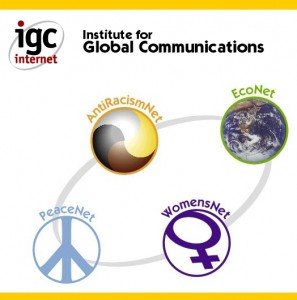 In the 1980’s it was possible for groups to setup their own dial up Bulletin Board Systems (BBS) via local or long distance phone services. By the late 1980’s the first free global online network called FidoNet allowed groups to share resources with just a local phone call, but in most instances becoming a Fidonet member was far beyond the technical skills of all but a few anti-nuclear groups around the world. The AA Clearinghouse had such a nerd on staff, and had a global online presence by 1990, and earlier via PeaceNet. The WWW would make it possible for groups to have their own dedicated websites that anyone in the world could access as search engines like Yahoo helped to make networking prominent.
In the 1980’s it was possible for groups to setup their own dial up Bulletin Board Systems (BBS) via local or long distance phone services. By the late 1980’s the first free global online network called FidoNet allowed groups to share resources with just a local phone call, but in most instances becoming a Fidonet member was far beyond the technical skills of all but a few anti-nuclear groups around the world. The AA Clearinghouse had such a nerd on staff, and had a global online presence by 1990, and earlier via PeaceNet. The WWW would make it possible for groups to have their own dedicated websites that anyone in the world could access as search engines like Yahoo helped to make networking prominent.
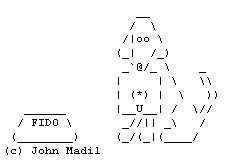 The most recent online evolution was known as Web 2.0 that started to emerge around 2005, with what is more commonly known today as Social Media with entities like Facebook, Google and then Twitter, that was then driven by wireless cell phones. By 2016 email and to a lessor extent websites have been in decline due this monster services. Concern around privacy over corporate and federal spying has not been a comfortable issue as many aging activists have not been able to shift between this tech evolution.
The most recent online evolution was known as Web 2.0 that started to emerge around 2005, with what is more commonly known today as Social Media with entities like Facebook, Google and then Twitter, that was then driven by wireless cell phones. By 2016 email and to a lessor extent websites have been in decline due this monster services. Concern around privacy over corporate and federal spying has not been a comfortable issue as many aging activists have not been able to shift between this tech evolution.
The Good
Nuclear Waste
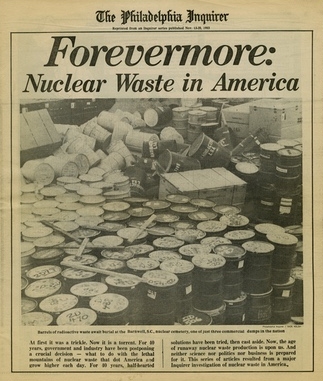 The Philadelphia Enquirer’s week long investigation of the nuclear fuel cycle was turned into a book that is available – with the following review by Amazon.
The Philadelphia Enquirer’s week long investigation of the nuclear fuel cycle was turned into a book that is available – with the following review by Amazon.
Back in 1983, Pulitzer Prize-winning reporters Donald Barlett and James Steele from the Philadelphia Inquirer spent eighteen months investigating reactor sites and nuclear waste cemeteries, conducting interviews and gathering documents to ferret out little-known information about a grave technical political problem: how to dispose safely of nuclear wastes accumulating at the many nuclear plants around the nation. Their Poe-esque title carries a grisly meaning: millennia from now successive generations may be contaminated by radioactive wastes we bury ‘safely’ today.” ?Publishers Weekly
For eighteen months, Barlett & Steele traveled some 20,000 miles, interviewing dozens of people and assembling more than 125,000 pages of documents. These included local, state, and federal government reports, state and federal court records, corporate files, congressional hearing transcripts, scientific studies, and internal memoranda of public agencies and private businesses. The resulting newspaper series provoked a much broader reaction than we had anticipated. In response to requests for copies of the articles, more than 25,000 reprints were sent to individuals and organizations in more than forty states and several foreign countries. Many of those who wrote urged the authors to expand the newspaper series into a book. In doing so, they updated the material and added new information, including sections on military waste, foreign reprocessing, and uranium mill tailings. We were tempted to delve into other areas, such as the design and construction of reactors and the economics of nuclear power. But we focused instead on waste?the amount produced, past efforts to manage it, and the politics of its disposal.
Nuclear Weapons & the Department of Energy Fuel Cycle
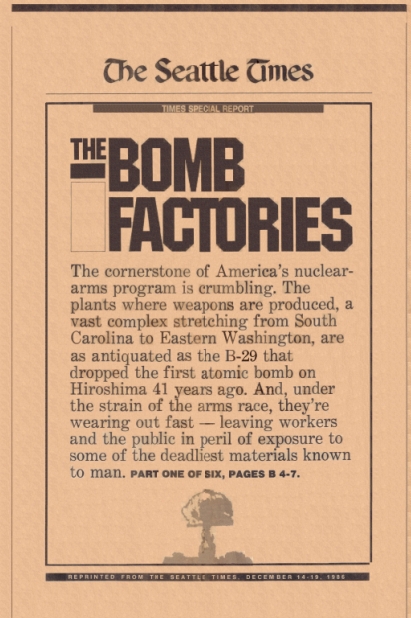 For an entire week in December 1986, the Seattle Times did a daily, front page investigative report that went on for multiple full pages in the paper that covered the entire Dept. of Energy weapons infrastructure nationwide. Some of the most unknown scandals the weapons industry had been hiding from the public were first publicly disclosed to a large audience in this amazing investigative series. One of the most dramatic of which was the intentional release of hundreds of thousands of curies of Iodine 131 back in the 1950’s that spread across the entire state of Washington, that eventually led to women there having the highest rates of breast cancer in the country…
For an entire week in December 1986, the Seattle Times did a daily, front page investigative report that went on for multiple full pages in the paper that covered the entire Dept. of Energy weapons infrastructure nationwide. Some of the most unknown scandals the weapons industry had been hiding from the public were first publicly disclosed to a large audience in this amazing investigative series. One of the most dramatic of which was the intentional release of hundreds of thousands of curies of Iodine 131 back in the 1950’s that spread across the entire state of Washington, that eventually led to women there having the highest rates of breast cancer in the country…
But of course, the story hardly stopped there. Americans had been told following Chernobyl that we had no reactors of similar design, but there at Hanford was a similar reactor (N-Reactor) that was quietly shut down after the series came out about its existence. Many more scandals exposing the rapidly deteriorating state of the DOE’s operations, especially at Hanford also came out – later stories like the one where the Mounds Facility in Ohio, where the admin intentionally contaminated workers health records and then dumped them in a nuclear waste dump across the country would help to launch a national campaign for hundreds of thousands of workers who were dying from contamination.
This particular series of stories would barely make it out of the Seattle area, but a few activists around the country would be sent copies that would help to set off the scandal. Today, there is no online evidence of this incredible series in existence. Another Seattle newspaper, the Post-Intelligencer, that also helped with the above series did another major investigative series in 2001 on the environmental impacts of mining, including uranium that has happened thanks to the legacy of the 1872 Mining Act that allows global corporations to steal, contaminate and abandon federally owned lands across the west. The daily newspaper collapsed soon after and tried to reorganize as an online newspaper.
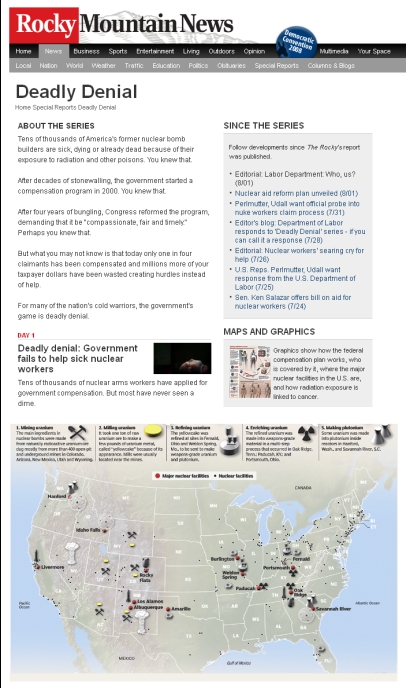 The Rocky Mountain News published a three day series covering the impacts to nuclear weapons workers in 2008. This investigation covered what sas happened to the hundreds of thousands of Department of Energy (DOE) workers nationwide, with a local focus on DOE’s Rocky Flats workers in Colorado.
The Rocky Mountain News published a three day series covering the impacts to nuclear weapons workers in 2008. This investigation covered what sas happened to the hundreds of thousands of Department of Energy (DOE) workers nationwide, with a local focus on DOE’s Rocky Flats workers in Colorado.
It detailed the history of how federal employees were finally able to get congress to enact legislation that was meant to help dying workers and their families, but instead was turned on them. As a result of this series and national pressure, the entire program was yanked from DOE’s control and moved to the Dept. of Labor.
Even with over a billion dollars spent, the program continued to be used as a weapon against most of the workers who were seeking medical and financial help. Included in the presentation are extensive documentation of how the government has ganged up on workers. Some of the worst examples of this were not mentioned, for example, how DOE administrators at the Fernald Ohio facility intentionally contaminated workers health records with radiation and then had them dump in a nuclear wast dump half way across the country. The documentary helped publicize the class action suit against DOE that led to a $400 million settlement that was then appealed, but still gained over $300 million for workers and the exposed public at Rocky Flats.
The Rocky Mountain News also ceased daily production shortly after publishing this series, eventually reopening as an online newspaper only.
Abandoned Uranium Mine Impacts on First Nations
There has been many books written about the impacts of abandoned uranium mines on First Nation People that have been going on for over four decades, but it would take a multi-series investigative report done by the Los Angeles Times in 2006 that would help launch long dead congressional investigations of the tragic impacts to Dine People in the “National Sacrifice Zone” in the four corners area of the united states. Sadly, most of the incredible images from this series has been wiped from Judy Pasternak’s incredible story. Below is a sample of one of the images stripped from the series. Congressional hearings helped put the abandoned uranium mining issue back in the public eye for awhile. The EPA region 9 would be caught attempting to scrub all of its documentation of the impacts from its online website – and be required to re-post the documents. By just spending years to do studies the entire nightmare once again died, only to be used as a political football by the Obama administration near the end of his 2nd term after it laid dormant for 8 more years.  But some of the most unsung reporting of what has happened comes from years of dedicated work by Kathy Helms and others who did the daily stories on the ground covering the battles of the people who had to live through contaminated homes and drinking sources, not to mention the corrupting money game that the mining companies played on the financially strapped people.
But some of the most unsung reporting of what has happened comes from years of dedicated work by Kathy Helms and others who did the daily stories on the ground covering the battles of the people who had to live through contaminated homes and drinking sources, not to mention the corrupting money game that the mining companies played on the financially strapped people.
The Rapid City South Dakota Journal would also do an extended investigation of radiation in that state that is still online documenting the history of uranium mining and its abandoned mines there as well. There are, of course, many activist resources like Wise Uranium that have long been documenting this issue worldwide with some of the most incredible resources coming out of Australia! The Rapid City South Dakota Journal would also do an extended investigation of radiation in that state that is still online documenting the history of uranium mining and its abandoned mines there as well. There are, of course, many activist resources like Wise Uranium that have long been documenting this issue worldwide with some of the most incredible resources coming out of Australia!
California and Diablo Canyon
California has the oldest anti-nuclear power movement in the nation. Starting with opposition to Pacific Gas & Electric’s plan in 1958 to build a nuclear complex directly over the epicenter of 1906 San Andreas fault line that destroyed San Francisco at Bodega Bay, Californians over the last fifty years have successfully blocked dozens of proposed nuclear power stations across the state. There has never been any full documentation of the movement by any major media outlet, ever. In fact, a well made documentary of opposition at Diablo Canyon that was first released shortly after Chernobyl was blocked from being shown on KQED, the local PBS TV station. California was once planned to be the shining example of nuclear energy as PG&E openly bragged that it planned to build over 60 facilities in its service territory today. Yet, in 2016, the company finally agreed to close its last facility – Diablo Canyon.
The Diablo Canyon Timeline
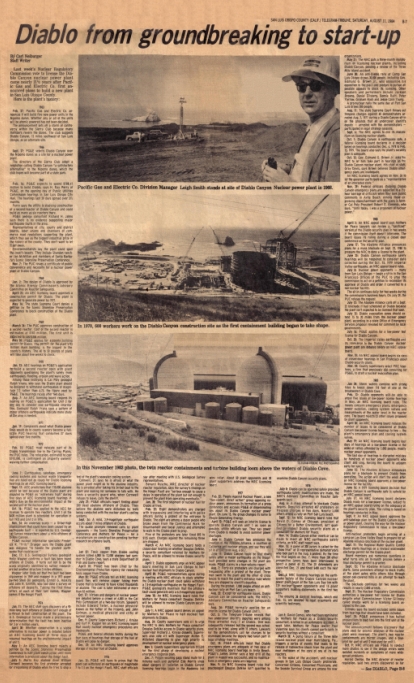 The Diablo Canyon nuclear station was first conceived of in 1963 by PG&E. The station was originally planned to house five reactors, with only two ever being constructed. The controversy over its constructed included the breakup of the Sierra Club, with its director David Brower and other leaving to from Friends of the Earth in 1969 when the Club’s board cut a deal with PG&E to endorse the facility.
The Diablo Canyon nuclear station was first conceived of in 1963 by PG&E. The station was originally planned to house five reactors, with only two ever being constructed. The controversy over its constructed included the breakup of the Sierra Club, with its director David Brower and other leaving to from Friends of the Earth in 1969 when the Club’s board cut a deal with PG&E to endorse the facility.
The reactors would not get legal permission to online until 1986, after two rebuilds, due to it’s close proximity to large earthquake faults that the San Luis Obispo chapter of the Sierra Club warned about from 1965 onward. The economic fallout was immense, having originally estimated to cost just over $300 million, but eventually costing $5.8 billion just in construction costs, not to mention nearly $7 billion in financing and over $3 billion in decommissioning costs. A CPUC estimate in 1988 placed the overall layout of capital during its initial 30 years of operation at over $50 billion.
Just after its opening in August of 1984, the San Luis Obispo Tribune put publish a multi-page timeline of the its controversial past. Here is a copy of that piece, with additional notes taking the story through its controversial financing process with the California Public Utilities Commission.
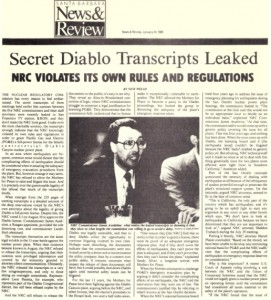 The pinnacle of the controversy at Diablo Canyon came when the Nuclear Regulatory Commission (NRC) illegally gave PG&E the permission to start the facility in August 1984. One of the NRC commissioners was so upset at the commission’s illegal action that he released the transcripts of meeting to the local KRON TV station in January 1985. The transcripts would result in legal action demanding that the facility be put on hold the case was reviewed by the Washington D.C. Court of Appeals. In a dramatic decision the day before Chernobyl, Judge Robert Bork (Nixon’s infamous Saturday Night Massacre lawyer) would decide that looking at the transcripts would be an act of judicial activism, allowing the facility to go ahead.
The pinnacle of the controversy at Diablo Canyon came when the Nuclear Regulatory Commission (NRC) illegally gave PG&E the permission to start the facility in August 1984. One of the NRC commissioners was so upset at the commission’s illegal action that he released the transcripts of meeting to the local KRON TV station in January 1985. The transcripts would result in legal action demanding that the facility be put on hold the case was reviewed by the Washington D.C. Court of Appeals. In a dramatic decision the day before Chernobyl, Judge Robert Bork (Nixon’s infamous Saturday Night Massacre lawyer) would decide that looking at the transcripts would be an act of judicial activism, allowing the facility to go ahead.
The Bad
Probably the worst example of media coverage of the nuclear comes from the NY Times that dates back to the days of Hiroshima, right up to the present.
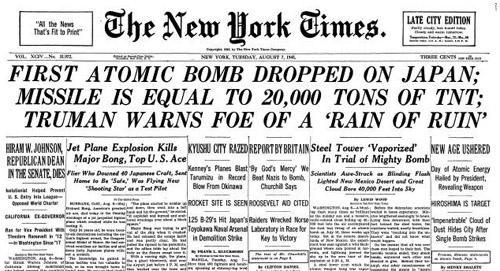 The Times has long been the major cheerleader of everything nuclear and has made no bones about its job of giving the nuclear industry the last word on every piece it does on the subject. Most of the other major daily newspapers across the country can be added to this list of big time promoters of anything nuclear. Mathew Wald, the Times nuclear correspondent retired after decades to a cushy job working for the nuclear industry.
The Times has long been the major cheerleader of everything nuclear and has made no bones about its job of giving the nuclear industry the last word on every piece it does on the subject. Most of the other major daily newspapers across the country can be added to this list of big time promoters of anything nuclear. Mathew Wald, the Times nuclear correspondent retired after decades to a cushy job working for the nuclear industry.
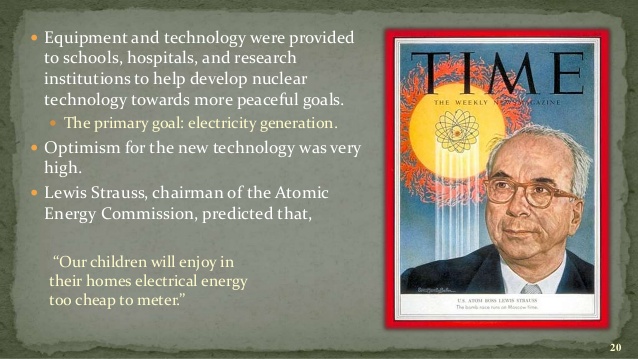 Back in the 1980’s San Francisco’s two major daily newspapers did everything they could to hide the growing national scandals, the size of global movement all for the benefit of Pacific Gas & Electric Co. and its troubled Diablo Canyon. The Abalone Alliance’s local chapter actually had the pleasure of having a spy within the SF Chronicle that turned us on to the media tactics used to not just censor news coverage but intentionally manipulate the public’s opinions on the nuclear issue. For example, when the lawsuit by the industry finally failed to for the AA to pay for its 1981 blockade, the story was on the front page of the paper in San Luis Obispo, but on the obituary page in SF. While the Chron staff person showed us copies of stories that showed the full scale manipulation of content depending on its intended audience. In fact he was ordered not to publish any nuclear news from the wire service unless cleared by senior editors, upon the pain of firing.
Back in the 1980’s San Francisco’s two major daily newspapers did everything they could to hide the growing national scandals, the size of global movement all for the benefit of Pacific Gas & Electric Co. and its troubled Diablo Canyon. The Abalone Alliance’s local chapter actually had the pleasure of having a spy within the SF Chronicle that turned us on to the media tactics used to not just censor news coverage but intentionally manipulate the public’s opinions on the nuclear issue. For example, when the lawsuit by the industry finally failed to for the AA to pay for its 1981 blockade, the story was on the front page of the paper in San Luis Obispo, but on the obituary page in SF. While the Chron staff person showed us copies of stories that showed the full scale manipulation of content depending on its intended audience. In fact he was ordered not to publish any nuclear news from the wire service unless cleared by senior editors, upon the pain of firing.
Today, surveys show that the public has lost trust in the major news media. The recent news about advertisers pulling their accounts from a conservative news commentator that resulted in his removal is a classic example of business as usual for entire issues like nuclear. The overt agenda, or bias of corporate owned media conglomerates, especially for anything labeled “in the national interest” makes the nuclear issue “a canary in the coal mine” example of just how truly damaging the consumer driven news media is with its bottom line history of pro-nuclear propaganda that has long been protecting both the nuclear power and weapons issue for serious public critique.
The Ugly
Forbes: “The failure of the U.S. nuclear power program ranks as the largest managerial disaster in business history.”
 In February 1985, Forbes Magazine published a 35 page investigative piece on the financial collapse of America’s nuclear energy industry. On the cover of the piece would be one of the most powerful epitaphs of nuclear power ever written by the media. Why would the Forbes piece not be included the good section on nuclear? Because, the piece claimed that the industry’s failure had nothing to do with public opposition.
In February 1985, Forbes Magazine published a 35 page investigative piece on the financial collapse of America’s nuclear energy industry. On the cover of the piece would be one of the most powerful epitaphs of nuclear power ever written by the media. Why would the Forbes piece not be included the good section on nuclear? Because, the piece claimed that the industry’s failure had nothing to do with public opposition.
By making such a claim, the magazine failed, like most of the rest of this country’s media to acknowledge the role the anti-nuclear movement had been fighting since the 1950’s in blocking hundreds of nuclear reactors from ever opening. By censoring the concerns and activism of millions of people around the world, it does disservice to the dedicated work of people that have dedicated their lives to stopping the nuclear nightmare. For your reading pleasure…
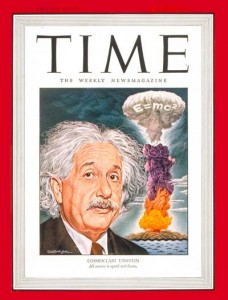 Albert Einstein urged President Roosevelt in 1939 to initiate the Manhattan project would be smeared by Life, which in 1949 listed Einstein as one of 50 prominent US “dupes and fellow travelers” used as “weapons” by communists.
Albert Einstein urged President Roosevelt in 1939 to initiate the Manhattan project would be smeared by Life, which in 1949 listed Einstein as one of 50 prominent US “dupes and fellow travelers” used as “weapons” by communists.
In 1950, Einstein appeared on an NBC program called “Today With Mrs. Roosevelt.” He made a speech warning Americans that the “idea of achieving security through national armament is… a disastrous illusion,” that the arms race between the US and the Soviet Union had assumed a “hysterical character,” and that with the advent of hydrogen bombs, “radioactive poisoning of the atmosphere and hence annihilation of any life on Earth has been brought within the range of technical possibilities.”
In 1946, Albert Einstein, Leo Szilard and other prominent scientists formed the Emergency Committee of Atomic Scientists (ECAS) to aid public understanding of pressing atomic issues.
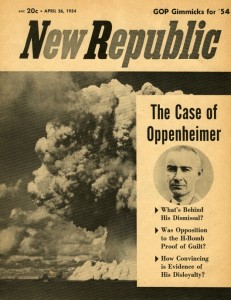 Other prominent scientists like J. Robert Oppenheimer, who led the government’s program to build the first atomic bomb would also be smeared during the height of the “Red Scare”, having his carreer ruined for standing up publicly against the expansion of the nuclear weapons program by the McCarthyists that would purge many prominent writers, Hollywood personalities, labor activivists and leftists across the U.S.
Other prominent scientists like J. Robert Oppenheimer, who led the government’s program to build the first atomic bomb would also be smeared during the height of the “Red Scare”, having his carreer ruined for standing up publicly against the expansion of the nuclear weapons program by the McCarthyists that would purge many prominent writers, Hollywood personalities, labor activivists and leftists across the U.S.
